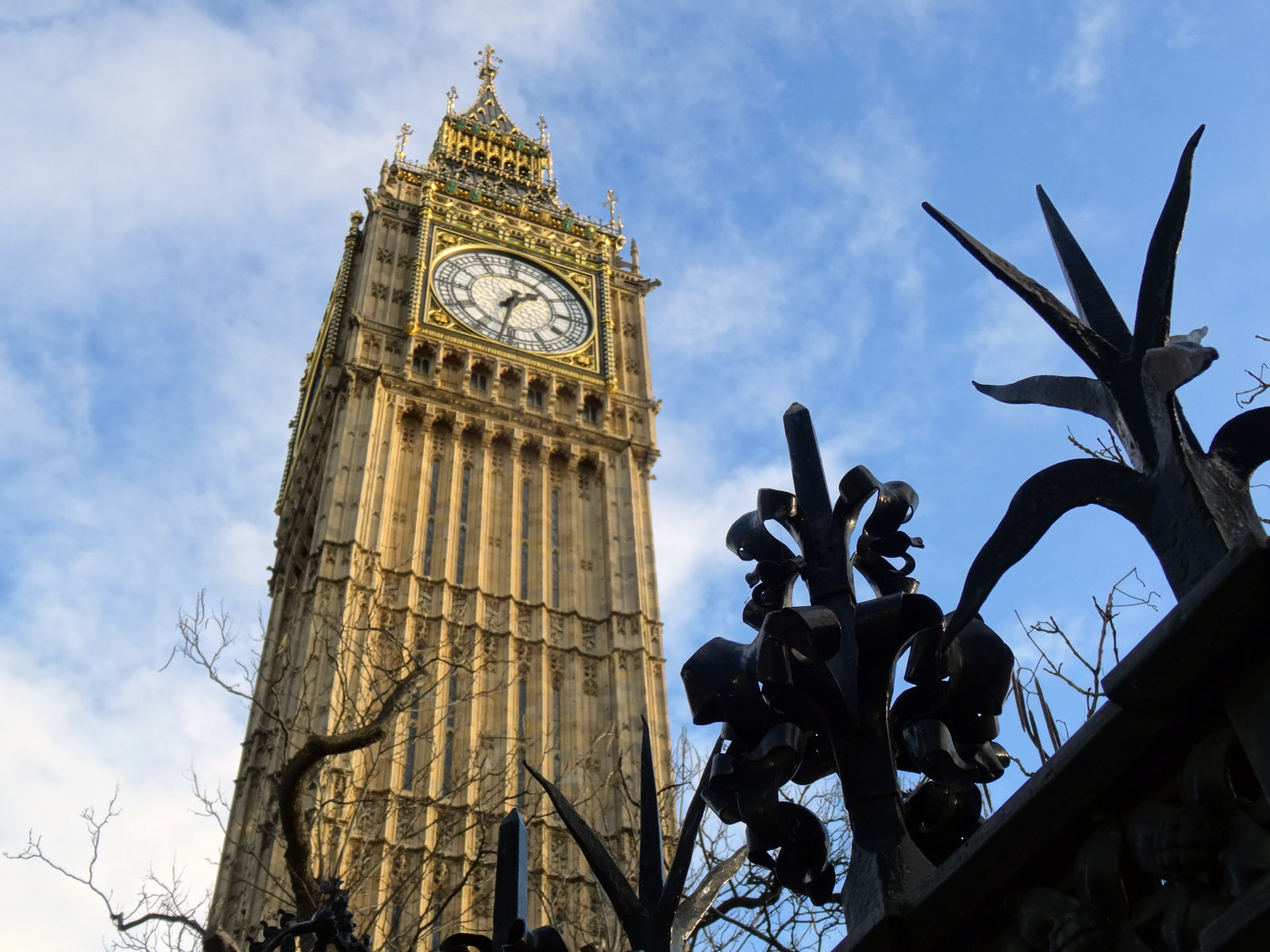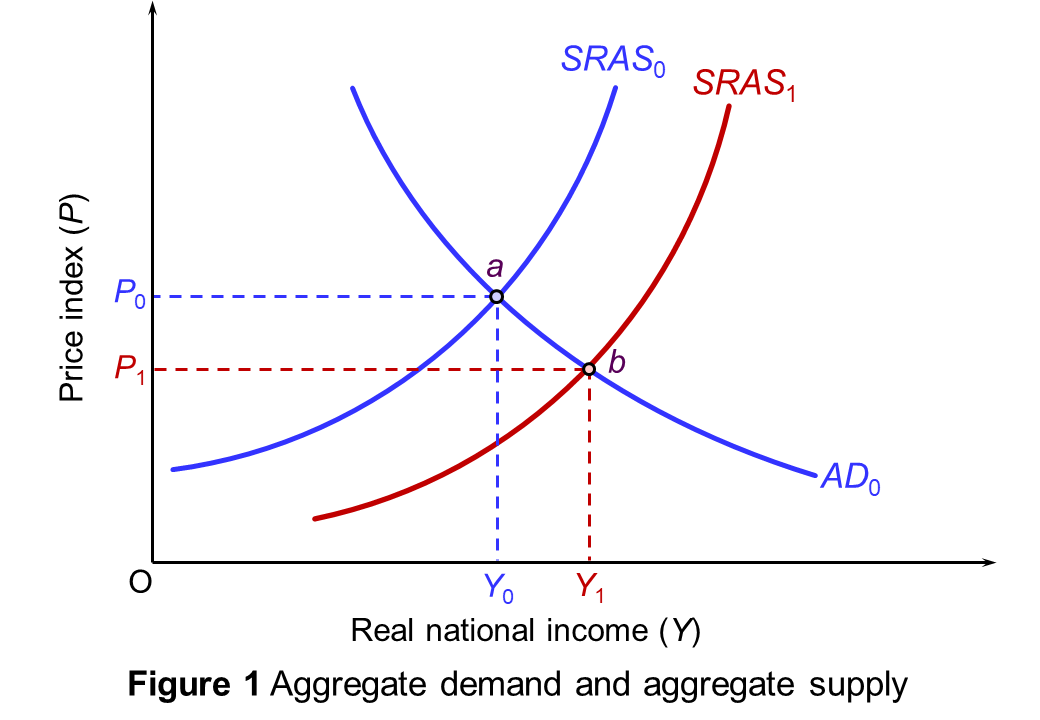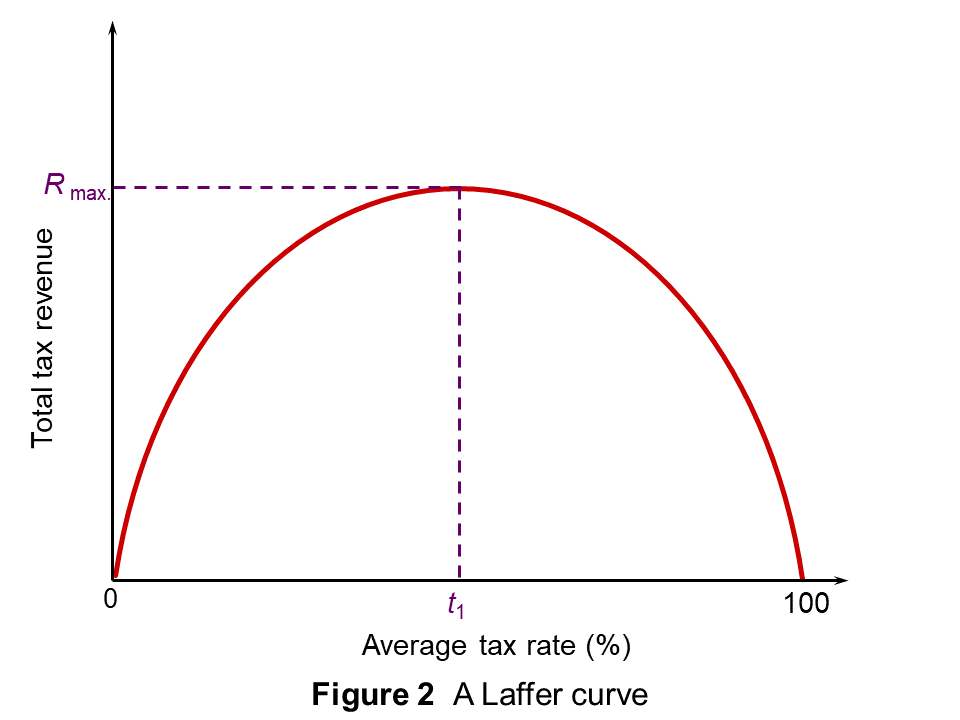 In her bid to become Conservative party leader, Liz Truss promised to make achieving faster economic growth her number-one policy objective. This would involve pursuing market-orientated supply-side policies.
In her bid to become Conservative party leader, Liz Truss promised to make achieving faster economic growth her number-one policy objective. This would involve pursuing market-orientated supply-side policies.
These policies would include lower taxes on individuals to encourage people to work harder and more efficiently, and lower taxes on business to encourage investment. The policy would also involve deregulation, which would again encourage investment, both domestic and inward investment from overseas. These proposals echoed the policies pursued in the 1980s by President Ronald Reagan in the USA and Margaret Thatcher in the UK.
On September 23, the new Chancellor, Kwasi Kwarteng, presented a ‘mini-Budget’ – although the size of the changes made it far from ‘mini’. This, as anticipated, included policies intended to boost growth, including scrapping the 45% top rate of income tax, which is currently paid by people earning over £150 000 (a policy withdrawn on 3 October after massive objections), cutting the basic rate of income tax from 20% to 19%, scrapping the planned rise in corporation tax from 19% to 25%, scrapping the planned rise in national insurance by 1.25 percentage points, a cut in the stamp duty on house purchase and scrapping the limit placed on bankers’ bonuses. In addition, he announced the introduction of an unlimited number of ‘investment zones’ which would have lower business taxes, streamlined planning rules and lower regulation. The policies would be funded largely from extra government borrowing.
 Theoretically, the argument is simple. If people do work harder and firms do invest more, then potential GDP will rise – a rise in aggregate supply. This can be shown on an aggregate demand and supply diagram. If the policy works, the aggregate supply curve will shift to the right. Real GDP will rise and there will be downward pressure on prices. In Figure 1, real GDP will rise from Y0 to Y1 and the price level will fall from P0 to P1. However, things are not as simple as this. Indeed, there are two major problems.
Theoretically, the argument is simple. If people do work harder and firms do invest more, then potential GDP will rise – a rise in aggregate supply. This can be shown on an aggregate demand and supply diagram. If the policy works, the aggregate supply curve will shift to the right. Real GDP will rise and there will be downward pressure on prices. In Figure 1, real GDP will rise from Y0 to Y1 and the price level will fall from P0 to P1. However, things are not as simple as this. Indeed, there are two major problems.
The first concerns whether tax cuts will incentivise people to work harder. The second concerns what happens to aggregate demand. I addition to this, the policies are likely to have a profound effect on income distribution.
Tax cuts and incentives
Cutting the top rate of income tax would have immediately given people at the top of the income scale a rise in post-tax income. This would have created a substitution effect and an income effect. Each extra pound that such people earn would be worth more in post-tax income – 60p rather than 55p. This would provide an incentive for people to substitute work for leisure as work is now more rewarding. This is the substitution effect. On the other hand, with the windfall of extra income, they now would have needed to work less in order to maintain their post-tax income at its previous level. They may well indeed, therefore, have decided to work less and enjoy more leisure. This is the income effect.
With the diminishing marginal utility of income, generally the richer people are, the bigger will be the income effect and the smaller the substitution effect. Thus, cutting the top rate of income tax may well have led to richer people working less. There is no evidence that the substitution effect would be bigger.
 If top rates of income tax are already at a very high level, then cutting then may well encourage more work. After all, there is little incentive to work more if the current rate of tax is over 90%, say. Cutting them to 80% could have a big effect. This was the point made by Art Laffer, one of Ronald Reagan’s advisors. He presented his arguments in terms of the now famous ‘Laffer curve’, shown in Figure 2. This shows the total tax revenue raised at different tax rates.
If top rates of income tax are already at a very high level, then cutting then may well encourage more work. After all, there is little incentive to work more if the current rate of tax is over 90%, say. Cutting them to 80% could have a big effect. This was the point made by Art Laffer, one of Ronald Reagan’s advisors. He presented his arguments in terms of the now famous ‘Laffer curve’, shown in Figure 2. This shows the total tax revenue raised at different tax rates.
If the average tax rate were zero, no revenue would be raised. As the tax rate is raised above zero, tax revenues will increase. The curve will be upward sloping. Eventually, however, the curve will peak (at tax rate t1). Thereafter, tax rates become so high that the resulting fall in output more than offsets the rise in tax rate. When the tax rate reaches 100 per cent, the revenue will once more fall to zero, since no one will bother to work.
If the economy were currently to the right of t1, then cutting taxes would increase revenue as there would be a major substitution effect. However, most commentators argue that the UK economy is to the left of t1 and that cutting the top rate would reduce tax revenues. Analysis by the Office for Budget Responsibility in 2012 suggested that t1 for the top rate of income tax was at around 48% and that cutting the rate below that would reduce tax revenue. Clearly according to this analysis, 40% is considerably below t1.
As far as corporation tax is concerned, the 19% rate is the lowest in the G20 and yet the UK suffers from low rates of both domestic investment and inward direct investment. There is no evidence that raising it somewhat, as previously planned, will cut investment. And as far as individual entrepreneurs are concerned, cutting taxes is likely to have little effect on the desire to invest and expand businesses. The motivation of entrepreneurs is only partly to do with the money. A major motivation is the sense of achievement in building a successful business.
Creating investment zones with lower taxes, no business rates and lower regulations may encourage firms to set up there. But much of this could simply be diverted investment from elsewhere in the country, leaving overall investment little changed.
To assess these questions, the government needs to model the outcomes and draw on evidence from elsewhere. So far this does not seem to have happened. They government did not even present a forecast of the effects of its policies on the public finances, something that the OBR normally presents at Budget time. This was one of the reasons for the collapse in confidence of sterling and gilts (government bonds) in the days following the mini-Budget.
Effects on aggregate demand
 Cutting taxes and financing them from borrowing will expand aggregate demand. In Figure 1, the AD curve will also shift to the right and this will push up prices. Inflation is already a serious problem in the economy and unfunded tax cuts will make it worse. Higher inflation will result in the Bank of England raising interest rates further to curb aggregate demand. But higher interest rates, by raising borrowing costs, are likely to reduce investment, which will have a negative supply-side effect.
Cutting taxes and financing them from borrowing will expand aggregate demand. In Figure 1, the AD curve will also shift to the right and this will push up prices. Inflation is already a serious problem in the economy and unfunded tax cuts will make it worse. Higher inflation will result in the Bank of England raising interest rates further to curb aggregate demand. But higher interest rates, by raising borrowing costs, are likely to reduce investment, which will have a negative supply-side effect.
The problem here is one of timing. Market-orientated supply-side policies, if they work to increase potential GDP, will take time – measured in years rather than months. The rise in aggregate demand will be much quicker and will thus precede the rise in supply. This could therefore effectively kill off the rise in supply as interest rates rise, the exchange rate falls and the economy is pushed towards recession. Indeed, the mini-Budget immediately sparked a run on the pound and the exchange rate fell.
The rising government debt may force the government to make cuts in public expenditure. Rather than cutting current expenditure on things such as nurses, teachers and benefits, it is easier to cut capital expenditure on things such as roads and other infrastructure. But this will have adverse supply-side effects.
Effects on income distribution
 Those advocating market-orientated supply-side policies argue that, by making GDP bigger, everyone can gain. They prefer to focus on the size of the national ‘pie’ rather than its distribution. If the rich initially gain, the benefits will trickle down to the poorest in society. This trickle-down theory was popular in the 1980s with politicians such as Margaret Thatcher and Ronald Reagan and, more recently, with Republican presidents, such as Goerge W Bush and Donald Trump. There are two problems with this, however.
Those advocating market-orientated supply-side policies argue that, by making GDP bigger, everyone can gain. They prefer to focus on the size of the national ‘pie’ rather than its distribution. If the rich initially gain, the benefits will trickle down to the poorest in society. This trickle-down theory was popular in the 1980s with politicians such as Margaret Thatcher and Ronald Reagan and, more recently, with Republican presidents, such as Goerge W Bush and Donald Trump. There are two problems with this, however.
The first, which we have already seen, is whether such policies actually do increase the size of the ‘pie’.
The second is how much does trickle down. During the Thatcher years, income inequality in the UK grew, as it did in the USA under Ronald Reagan. According to an IMF study in 2015 (see the link to the IMF analysis below), policies that increase the income share of the poor and the middle class do increase growth, while those that raise the income share of the top 20 per cent result in lower growth.
After the mini-Budget was presented, the IMF criticised it for giving large untargeted tax cuts that would heighten inequality. The poor would gain little from the tax cuts. The changes to income tax and national insurance mean that someone earning £20 000 per year will gain just £167 per year, while someone earning £200 000 will gain £5220. What is more, the higher interest rates and higher prices resulting from the lower exchange rate are likely to wipe out the modest gains to the poor.
Podcast
Articles
- At a glance: What’s in the mini-budget?
BBC News (23/9/22)
- Mini-budget: What it means for you and your finances
BBC News, Kevin Peachey (23/8/22)
- Will this huge tax cutting gamble pay off?
BBC News, Faisal Islam (23/9/22)
- Kwasi Kwarteng faces U-turn on tax or spending cuts
BBC News, Faisal Islam (28/9/22)
- Nearly 300 UK mortgage deals pulled in a day as pound’s fall heralds rate rise
The Guardian, Zoe Wood (27/9/23)
- Rationale behind abolition of 45p tax rate reflects failed ideology
The Guardian, Arun Advani, David Burgherr and Andy Summers (29/9/23)
- The UK’s ‘Trussonomics’ crashes the pound and leaves investors shaking their heads
CNN, Allison Morrow (26/9/23)
- Mini budget: will Kwasi Kwarteng’s plan deliver growth?
The Conversation, Steve Schifferes (23/9/23)
- Only a U-turn by the government or the Bank of England will calm UK financial markets
The Conversation, Campbell Leith (28/9/22)
- IMF gives damning verdict on Britain’s tax cuts
CNBC, Hannah Ward-Glenton (28/9/23)
- Lasting effects of ‘mini’ Budget will be felt far beyond the trading floors
Today News, Torsten Bell (1/10/23)
Analysis
- Causes and Consequences of Income Inequality: A Global Perspective
IMF Staff Discussion Notes, Era Dabla-Norris, Kalpana Kochhar, Nujin Suphaphiphat, Franto Ricka and Evridiki Tsounta (15/6/15)
- Mini-Budget response
Institute for Fiscal Studies, Stuart Adam, Isaac Delestre, Carl Emmerson, Paul Johnson, Robert Joyce, Isabel Stockton, Tom Waters, Xiaowei Xu and Ben Zaranko (23/9/22)
Questions
- Distinguish between market-orientated supply-side policies and interventionist ones. Consider the advantages and disadvantages of each.
- Explain why bond prices fell after the mini-Budget. What was the Bank of England’s response and why did this run counter to its plan for quantitative tightening?
- How might a tax-cutting Budget be designed to help the poor rather than the rich? Would this have beneficial supply-side effects?
- Find out about the 1972 tax-cutting Budget of Anthony Barber, the Chancellor in Ted Heath’s government, that led to the ‘Barber boom’ and then rampant inflation. Are there any similarities between the 1972 Budget and the recent mini-Budget?
 One of the major economic concerns about the COVID-19 pandemic has been the likely long-term scarring effects on economies from bankruptcies, a decline in investment, lower spending on research and development, a loss of skills, discouragement of workers, disruption to education, etc. The result would be a decline in potential output or, at best, a slower growth. These persistent effects are known as ‘hysteresis’ – an effect that persists after the original cause has disappeared.
One of the major economic concerns about the COVID-19 pandemic has been the likely long-term scarring effects on economies from bankruptcies, a decline in investment, lower spending on research and development, a loss of skills, discouragement of workers, disruption to education, etc. The result would be a decline in potential output or, at best, a slower growth. These persistent effects are known as ‘hysteresis’ – an effect that persists after the original cause has disappeared.
In a speech by Dave Ramsden, the Bank of England’s Deputy Governor for Markets & Banking, he argued that, according to MPC estimates, the pandemic will have caused a loss of potential output of 1.75%. This shortfall may seem small at first sight, so does it matter? According to Ramsden:
The answer is definitely yes for two reasons. First, a 1¾% shortfall as a share of annual GDP for the UK … represents roughly £39 billion – for context, that’s about half of the education budget. And second, that 1¾% represents a permanent shortfall, or at least a very persistent one, on top of the impact of the immediate downturn. If you lose 1¾% of GDP every year for ten years, then in total you have lost 17.5% of one year’s GDP, or around £390bn in 2019 terms
However, as the IMF blog linked below argues, there may be positive supply-side effects which outweigh these scarring effects, causing a net rise in potential GDP growth. There are two possible reasons for this.
 The first is that the pandemic may have hastened the process of digitalisation and automation. Examples include ‘video conferencing and file sharing applications to drones and data-mining technologies’. According to evidence from a sample of 15 countries cited in the blog, a 10% rise in such intangible capital investment is associated with about a 4½% rise in labour productivity. ‘As COVID-19 recedes, the firms which invested in intangible assets, such as digital technologies and patents may see higher productivity as a result.’
The first is that the pandemic may have hastened the process of digitalisation and automation. Examples include ‘video conferencing and file sharing applications to drones and data-mining technologies’. According to evidence from a sample of 15 countries cited in the blog, a 10% rise in such intangible capital investment is associated with about a 4½% rise in labour productivity. ‘As COVID-19 recedes, the firms which invested in intangible assets, such as digital technologies and patents may see higher productivity as a result.’
The second is a reallocation of workers and capital to more productive sectors. Firms in some sectors, such as leisure, hospitality and retail, have relatively low labour productivity. Many parts of these industries have declined during the pandemic, especially those with high labour intensity. At the same time, there has been a rise in employment in firms where output per worker is higher. Such sectors include e-commerce and those where remote working is possible. The greater the reallocation from low labour-productivity to high labour-productivity sectors, the more will overall labour productivity rise and hence the more will potential output increase.
The size of these two effects will depend to a large extent on expectations, incentives and government policy. The blog cites four types of policy that can help investment and reallocation.
- Improved insolvency and restructuring procedures to enable capital in failed firms to be reallocated to sectors with potential for growth.
- Promoting competition to enable the exit and entry of firms into expanding sectors and to prevent powerful firms from blocking the process.
- Refocusing policy from retaining labour in existing jobs to reskilling workers for new jobs, thereby improving labour mobility from declining to expanding sectors.
- Addressing financial bottlenecks, so as to ensure adequate access to financing for viable firms.
Whether there will be a net increase or decrease in productivity from the pandemic very much depends on the extent to which firms and workers are able and willing to take advantage of new opportunities and the extent to which government supports investment in and reallocation to high-productivity sectors.
Blogs, articles and speeches
Questions
- Can actual economic growth be greater than potential economic growth (a) in the short run; (b) in the long run?
- Give some example of scarring effects from the COVID-19 pandemic.
- What effects might short-term policies to tackle the recession caused by the pandemic have on longer-term potential economic growth?
- What practical policies could governments adopt to encourage the positive supply-side effects of the pandemic? To what extent would these policies have negative short-term effects?
- Why might (endogenous) financial crises result in larger and more persistent reductions in potential output than exogenous crises, such as a pandemic or a war?
- Distinguish between interventionist and market-orientated supply-side policies to encourage the reallocation of labour and capital to higher-productivity sectors.
 According to Christine Lagarde, Managing Director of the IMF, the slow growth in global productivity is acting as a brake on the growth in potential income and is thus holding back the growth in living standards. In a recent speech in Washington she said that:
According to Christine Lagarde, Managing Director of the IMF, the slow growth in global productivity is acting as a brake on the growth in potential income and is thus holding back the growth in living standards. In a recent speech in Washington she said that:
Over the past decade, there have been sharp slowdowns in measured output per worker and total factor productivity – which can be seen as a measure of innovation. In advanced economies, for example, productivity growth has dropped to 0.3 per cent, down from a pre-crisis average of about 1 per cent. This trend has also affected many emerging and developing countries, including China.
We estimate that, if total factor productivity growth had followed its pre-crisis trend, overall GDP in advanced economies would be about 5 percent higher today. That would be the equivalent of adding another Japan – and more – to the global economy.
So why has productivity growth slowed to well below pre-crisis rates? One reason is an ageing working population, with older workers acquiring new skills less quickly. A second is the slowdown in world trade and, with it, the competitive pressure for firms to invest in the latest technologies.
 A third is the continuing effect of the financial crisis, with many highly indebted firms forced to make deep cuts in investment and many others being cautious about innovating. The crisis has dampened risk taking – a key component of innovation.
A third is the continuing effect of the financial crisis, with many highly indebted firms forced to make deep cuts in investment and many others being cautious about innovating. The crisis has dampened risk taking – a key component of innovation.
What is clear, said Lagarde, is that more innovation is needed to restore productivity growth. But markets alone cannot achieve this, as the benefits of invention and innovation are, to some extent, public goods. They have considerable positive externalities.
She thus called on governments to give high priority to stimulating productivity growth and unleashing entrepreneurial energy. There are several things governments can do. These include market-orientated supply-side policies, such as removing unnecessary barriers to competition, driving forward international free trade and cutting red tape. They also include direct intervention through greater investment in  education and training, infrastructure and public-sector R&D. They also include giving subsidies and/or tax relief for private-sector R&D.
education and training, infrastructure and public-sector R&D. They also include giving subsidies and/or tax relief for private-sector R&D.
Banks too have a role in chanelling finance away from low-productivity firms and towards ‘young and vibrant companies’.
It is important to recognise, she concluded, that innovation and structural change can lead to some people losing out, with job losses, low wages and social deprivation. Support should be given to such people through better education, retraining and employment incentives.
Articles
IMF chief warns slowing productivity risks living standards drop Reuters, David Lawder (3/4/17)
Global productivity slowdown risks social turmoil, IMF warns Financial Times, Shawn Donnan (3/4/17)
Global productivity slowdown risks creating instability, warns IMF The Guardian, Katie Allen (3/4/17)
The Guardian view on productivity: Britain must solve the puzzle The Guardian (9/4/17)
Speech
Reinvigorating Productivity Growth IMF Speeches, Christine Lagarde, Managing Director, IMF(3/4/17)
Paper
Gone with the Headwinds: Global Productivity IMF Staff Discussion Note, Gustavo Adler, Romain Duval, Davide Furceri, Sinem Kiliç Çelik, Ksenia Koloskova and Marcos Poplawski-Ribeiro (April 2017)
Questions
- What is the relationship between actual and potential economic growth?
- Distinguish between labour productivity and total factor productivity.
- Why has total factor productivity growth been considerably slower since the financial crisis than before?
- Is sustained productivity growth (a) a necessary and/or (b) a sufficient condition for a sustained growth in living standards?
- Give some examples of technological developments that could feed through into significant growth in productivity.
- What is the relationship between immigration and productivity growth?
- What policies would you advocate for increasing productivity? Explain why.
 The government has launched its promised industrial strategy by publishing a Green Paper which details the measures the government plans to take. This represents a move away from a laissez-faire approach to business and a move towards greater intervention.
The government has launched its promised industrial strategy by publishing a Green Paper which details the measures the government plans to take. This represents a move away from a laissez-faire approach to business and a move towards greater intervention.
There are 10 elements or ‘pillars’ of the policy. These include investing in science and technology, skills training and infrastructure – energy, transport, digital and water. They also include support to businesses, developing local institutions and encouraging trade and inward investment.
The drivers of the policy are planned to be a mixture of financial support, government procurement, new structures or organisations and laws and regulations. Details will be fleshed out in the coming months as the policy is enacted.
Reactions to the announcement have been mixed. An industrial policy is generally seen as an important element for improving the supply side of the economy by improving productivity and encouraging capacity growth. However, much of the criticism of the policy is that it does not go far enough. The following articles assess the policy – both its design and likely success.
Articles
Theresa May’s long-awaited “industrial strategy” looks a bit thin The Economist (28/1/17)
Factbox: The 10 pillars of Britain’s Modern Industrial Strategy Reuters, William James (23/1/17)
Theresa May give details of action plan for British industry BBC News (23/1/17)
Industry plan is break with ‘laissez-faire’ approach of the past Sky News, Ian King (23/1/17)
Skills and infrastructure top priority in industrial strategy, say UK firms The Guardian, Graham Ruddick (21/1/17)
The Guardian view on industrial strategy: hot air but no liftoff The Guardian (23/1/17)
The industrial strategy acknowledges a fundamental truth about growth New Statesman, Michael Jacobs (23/1/17)
European bosses underwhelmed by UK industrial revival plan Reuters, Ludwig Burger (27/1/17)
Is the UK finally getting serious about industrial strategy? Economia, David Bailey (25/1/17)
Government policy documents
Building our Industrial Strategy: Our 10 pillars HM Government (23/1/17)
Building our Industrial Strategy: Green Paper HM Government (23/1/17)
Questions
- Distinguish between interventionist and market-orientated supply-side policy. In terms of this distinction, how would you categorise the UK government’s industrial strategy?
- How will the strategy address the UK’s productivity puzzle?
- Go through each of the 10 pillars and assess how they will help to address weaknesses in the UK economy.
- How can government ‘missions’ to address major social challenges help to drive innovation? (See New Statesman article above.)
- How may Brexit help or hinder the government’s industrial strategy?
- The Economist article describes the strategy as looking thin. Do you agree?
 First the IMF in its World Economic Outlook, then the European Commission in its Economic Forecasts (see also) and now the OECD in its Economic Outlook (see also) – all three organisations in the latest issues of their 6-monthly publications are predicting slower global economic growth than they did 6 months previously. This applies both to the current year and to 2016. The OECD’s forecast for global growth this year is now 2.9%, down from the 3.7% it was forecasting a year ago. Its latest growth forecast for 2016 is 3.3%, down from the 3.9% it was forecasting a year ago.
First the IMF in its World Economic Outlook, then the European Commission in its Economic Forecasts (see also) and now the OECD in its Economic Outlook (see also) – all three organisations in the latest issues of their 6-monthly publications are predicting slower global economic growth than they did 6 months previously. This applies both to the current year and to 2016. The OECD’s forecast for global growth this year is now 2.9%, down from the 3.7% it was forecasting a year ago. Its latest growth forecast for 2016 is 3.3%, down from the 3.9% it was forecasting a year ago.
Various reasons are given for the gloomier outlook. These include: a dramatic slowdown in global trade growth; slowing economic growth in China and fears over structural weaknesses in China; falling commodity prices (linked to slowing demand but also as a result of increased supply); austerity policies as governments attempt to deal with the hangover of debt from the financial crisis of 2007/8; low investment leading to low rates of productivity growth despite technological progress; and general fears about low growth leading to low spending as people become more cautious about their future incomes.
 The slowdown in trade growth (forecast to be just 2% in 2015) is perhaps the most worrying for future global growth. As Angel Gurría, OECD Secretary-General, states in his remarks at the launch of the latest OECD Economic Outlook:
The slowdown in trade growth (forecast to be just 2% in 2015) is perhaps the most worrying for future global growth. As Angel Gurría, OECD Secretary-General, states in his remarks at the launch of the latest OECD Economic Outlook:
‘Global trade, which was already growing slowly over the past few years, appears to have stagnated and even declined since late 2014, with the weakness centering increasingly on emerging markets, particularly China. This is deeply concerning as robust trade and global growth go hand in hand. In 2015 global trade is expected to grow by a disappointing 2%. Over the past five decades there have been only five other years in which trade growth has been 2% or less, all of which coincided with a marked downturn of global growth.’
So what policies should governments pursue to stimulate economic growth? According to Angel Gurría:
‘Short-term demand needs to be supported and structural reforms to be pursued with greater ambition than is currently the case. Three specific actions are key:
|
|
| • |
First, we need to resist and turn back rising protectionism. Trade strengthens competition and investment and revs up the “diffusion machine” – the spread of new technologies throughout the economy – which will ultimately lift productivity. |
| • |
Second, we need to step up structural reform efforts, which have weakened in recent years. And here, I mean the whole range of structural reforms – education, innovation, competition, labour and product market regulation, R&D, taxes, etc. |
| • |
Third, there is scope to adjust public spending towards investment. If done collectively by all countries, if the sector and projects chosen have high multipliers, and if combined with serious structural reforms, stronger public investment can give a boost to growth and employment and not increase the relative debt burden.’ |
 On this third point, the OECD Economic Outlook argues that ‘the rationale for such investments is that they could help to push economies onto a higher growth path than might otherwise be the case, at a time when private investment growth remains modest.’
On this third point, the OECD Economic Outlook argues that ‘the rationale for such investments is that they could help to push economies onto a higher growth path than might otherwise be the case, at a time when private investment growth remains modest.’
‘Collective action to increase public investment can be expected to boost the initial domestic multiplier effects from the stimulus, since private investment and exports in each economy will benefit from stronger demand in other economies. …the multiplier effects from an investment-led stimulus are likely to be a little larger than from other forms of fiscal stimulus, since the former also has small, but positive, supply-side effects.
In other words, the OECD is calling for a relaxation of austerity policies, with public investment being used to provide a stimulus to growth. The higher growth will then lead to increased potential output, as well as actual output, and an increase in tax revenues.
These policy recommendations are very much in line with those of the IMF.
Videos and Webcasts
 OECD warns of global trade slowdown, trims growth outlook again Reuters (9/11/15)
OECD warns of global trade slowdown, trims growth outlook again Reuters (9/11/15)
 OECD returns to revisionism with growth downgrade Euronews, Robert Hackwill (9/11/15)
OECD returns to revisionism with growth downgrade Euronews, Robert Hackwill (9/11/15)
 OECD: Weak China Import Growth Leads Trade Slowdown Bloomberg, Catherine L Mann, OECD Chief Economist (9/11/15)
OECD: Weak China Import Growth Leads Trade Slowdown Bloomberg, Catherine L Mann, OECD Chief Economist (9/11/15)
 OECD Economic Outlook: Moving forward in difficult times OECD PowerPoint presentation, Catherine L Mann, OECD Chief Economist (9/11/15)
OECD Economic Outlook: Moving forward in difficult times OECD PowerPoint presentation, Catherine L Mann, OECD Chief Economist (9/11/15)
 Press Conference OECD, Angel Gurría and Álvaro Pereira (9/11/15)
Press Conference OECD, Angel Gurría and Álvaro Pereira (9/11/15)
Articles
OECD cuts world growth forecast Financial Times, Ferdinando Giugliano (9/11/15)
OECD rings alarm bell over threat of global growth recession thanks to China slowdown Independent, Ben Chu (10/11/15)
OECD cuts global growth forecasts amid ‘deep concern’ over slowdown BBC News (9/11/15)
OECD fears slowdown in global trade amid China woes The Guardian, Katie Allen (9/11/15)
The global economy is slowing down. But is it recession – or protectionism? The Observer, Heather Stewart and Fergus Ryan (14/11/15)
Global growth is struggling, but it is not all bad news The Telegraph, Andrew Sentance (13/11/15)
OECD Publications
Economic Outlook Annex Tables OCED (9/11/15)
Press Release: Emerging market slowdown and drop in trade clouding global outlook OCED (9/11/15)
Data handout for press OECD (9/11/15)
OECD Economic Outlook, Chapter 3: Lifting Investment for Higher Sustainable Growth OCED (9/11/15)
OECD Economic Outlook: Full Report OECD (9/11/15)
Questions
- Is a slowdown in international trade a cause of slower economic growth or simply an indicator of slower economic growth? Examine the causal connections between trade and growth.
- How worried should we be about disappointing growth in the global economy?
- What determines the size of the multiplier effects of an increase in public investment?
- Why are the multiplier effects of an increase in public-sector investment likely to be larger in the USA and Japan than in the UK, the eurozone and Canada?
- How can monetary policy be supportive of fiscal policy to stimulate economic growth?
- Under what circumstances would public-sector investment (a) stimulate and (b) crowd out private-sector investment?
- How would a Keynesian economist respond to the recommendations of the OECD?
- How would a neoclassical/neoliberal economist respond to the recommendations?
- Are the OECD’s recommendations in line with the Japanese government’s ‘three arrows‘?
- What structural reforms are recommended by the OECD? Are these ‘market orientated’ or ‘interventionist’ reforms, or both? Explain.
 In her bid to become Conservative party leader, Liz Truss promised to make achieving faster economic growth her number-one policy objective. This would involve pursuing market-orientated supply-side policies.
In her bid to become Conservative party leader, Liz Truss promised to make achieving faster economic growth her number-one policy objective. This would involve pursuing market-orientated supply-side policies. Theoretically, the argument is simple. If people do work harder and firms do invest more, then potential GDP will rise – a rise in aggregate supply. This can be shown on an aggregate demand and supply diagram. If the policy works, the aggregate supply curve will shift to the right. Real GDP will rise and there will be downward pressure on prices. In Figure 1, real GDP will rise from Y0 to Y1 and the price level will fall from P0 to P1. However, things are not as simple as this. Indeed, there are two major problems.
Theoretically, the argument is simple. If people do work harder and firms do invest more, then potential GDP will rise – a rise in aggregate supply. This can be shown on an aggregate demand and supply diagram. If the policy works, the aggregate supply curve will shift to the right. Real GDP will rise and there will be downward pressure on prices. In Figure 1, real GDP will rise from Y0 to Y1 and the price level will fall from P0 to P1. However, things are not as simple as this. Indeed, there are two major problems. If top rates of income tax are already at a very high level, then cutting then may well encourage more work. After all, there is little incentive to work more if the current rate of tax is over 90%, say. Cutting them to 80% could have a big effect. This was the point made by Art Laffer, one of Ronald Reagan’s advisors. He presented his arguments in terms of the now famous ‘Laffer curve’, shown in Figure 2. This shows the total tax revenue raised at different tax rates.
If top rates of income tax are already at a very high level, then cutting then may well encourage more work. After all, there is little incentive to work more if the current rate of tax is over 90%, say. Cutting them to 80% could have a big effect. This was the point made by Art Laffer, one of Ronald Reagan’s advisors. He presented his arguments in terms of the now famous ‘Laffer curve’, shown in Figure 2. This shows the total tax revenue raised at different tax rates. Cutting taxes and financing them from borrowing will expand aggregate demand. In Figure 1, the AD curve will also shift to the right and this will push up prices. Inflation is already a serious problem in the economy and unfunded tax cuts will make it worse. Higher inflation will result in the Bank of England raising interest rates further to curb aggregate demand. But higher interest rates, by raising borrowing costs, are likely to reduce investment, which will have a negative supply-side effect.
Cutting taxes and financing them from borrowing will expand aggregate demand. In Figure 1, the AD curve will also shift to the right and this will push up prices. Inflation is already a serious problem in the economy and unfunded tax cuts will make it worse. Higher inflation will result in the Bank of England raising interest rates further to curb aggregate demand. But higher interest rates, by raising borrowing costs, are likely to reduce investment, which will have a negative supply-side effect. Those advocating market-orientated supply-side policies argue that, by making GDP bigger, everyone can gain. They prefer to focus on the size of the national ‘pie’ rather than its distribution. If the rich initially gain, the benefits will trickle down to the poorest in society. This trickle-down theory was popular in the 1980s with politicians such as Margaret Thatcher and Ronald Reagan and, more recently, with Republican presidents, such as Goerge W Bush and Donald Trump. There are two problems with this, however.
Those advocating market-orientated supply-side policies argue that, by making GDP bigger, everyone can gain. They prefer to focus on the size of the national ‘pie’ rather than its distribution. If the rich initially gain, the benefits will trickle down to the poorest in society. This trickle-down theory was popular in the 1980s with politicians such as Margaret Thatcher and Ronald Reagan and, more recently, with Republican presidents, such as Goerge W Bush and Donald Trump. There are two problems with this, however. A Walk on the Supply Side
A Walk on the Supply Side One of the major economic concerns about the COVID-19 pandemic has been the likely long-term scarring effects on economies from bankruptcies, a decline in investment, lower spending on research and development, a loss of skills, discouragement of workers, disruption to education, etc. The result would be a decline in potential output or, at best, a slower growth. These persistent effects are known as ‘hysteresis’ – an effect that persists after the original cause has disappeared.
One of the major economic concerns about the COVID-19 pandemic has been the likely long-term scarring effects on economies from bankruptcies, a decline in investment, lower spending on research and development, a loss of skills, discouragement of workers, disruption to education, etc. The result would be a decline in potential output or, at best, a slower growth. These persistent effects are known as ‘hysteresis’ – an effect that persists after the original cause has disappeared.  The first is that the pandemic may have hastened the process of digitalisation and automation. Examples include ‘video conferencing and file sharing applications to drones and data-mining technologies’. According to evidence from a sample of 15 countries cited in the blog, a 10% rise in such intangible capital investment is associated with about a 4½% rise in labour productivity. ‘As COVID-19 recedes, the firms which invested in intangible assets, such as digital technologies and patents may see higher productivity as a result.’
The first is that the pandemic may have hastened the process of digitalisation and automation. Examples include ‘video conferencing and file sharing applications to drones and data-mining technologies’. According to evidence from a sample of 15 countries cited in the blog, a 10% rise in such intangible capital investment is associated with about a 4½% rise in labour productivity. ‘As COVID-19 recedes, the firms which invested in intangible assets, such as digital technologies and patents may see higher productivity as a result.’





